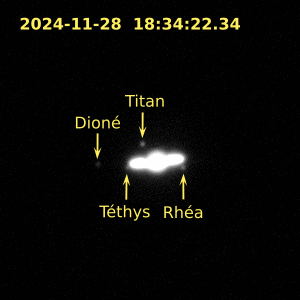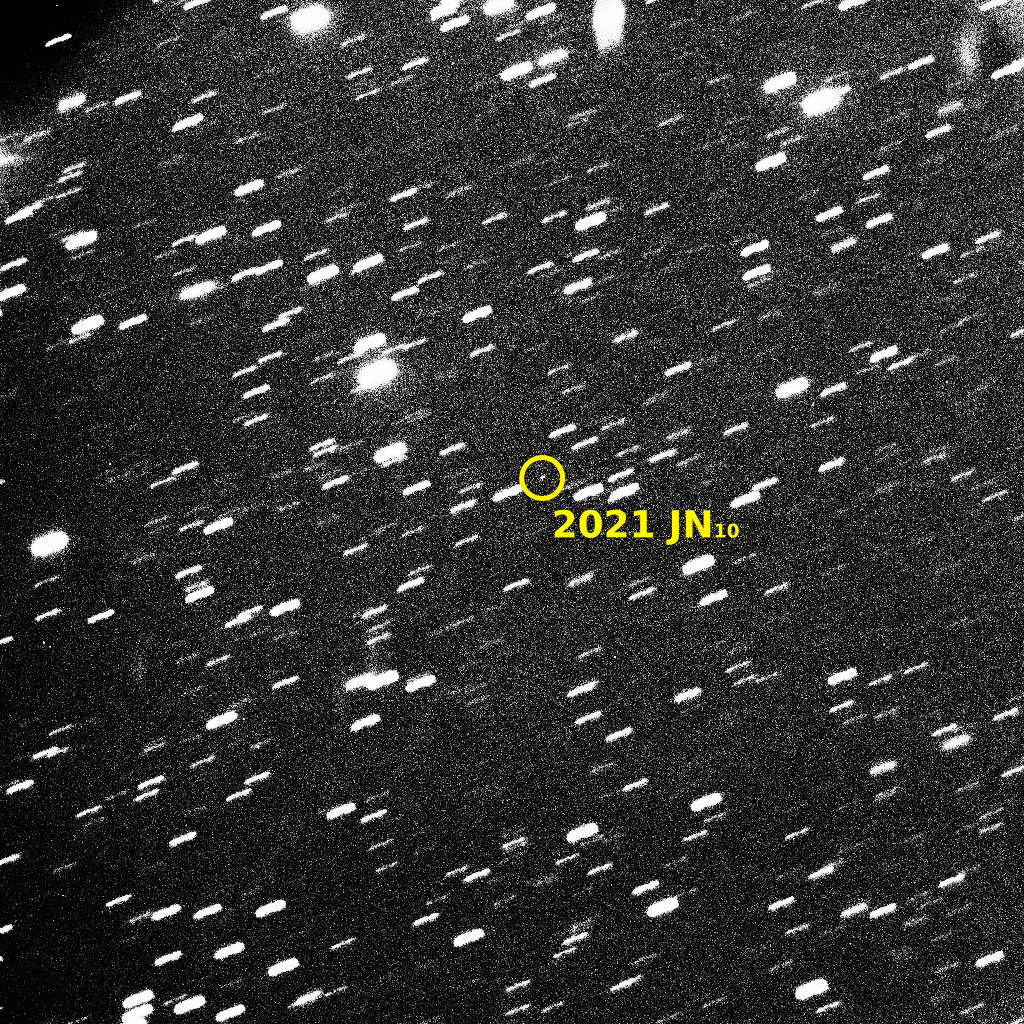Observations
Together with observers of the Pegase team, I perform observations of general interest for the scientific community, mostly dedicated to small Solar System bodies.
Asteroid astrometry
I take part in the follow up of Gaia alerts with William Thuillot. It consists in monitoring sources observed by the Gaia space telescope for which the brightness varies unexpectedly (e.g. supernovae). It also consists in recovering Solar System objects observed by Gaia but not identified among known bodies (Gaia-FUN-SSO).
The ground-based tracking of Gaia's trajectory itself (Gaia-GBOT) also leads to the discovery of many new objects that need to be confirmed with additional observations. Besides, we search for newly-discovered Near-Earth asteroids awaiting for confirmation (c.f. MPC webpage, or NEO Exchange).
Gaia-FUN-SSO in April 2021 ▿▵
Gaia-FUN-SSO in May 2022 ▿▵
New observations conducted by William Thuillot, together with Anne-Charlotte Perlbarg and Vincent Robert.


One year later, we observe again the "detached" trans-Neptunian object 2014 FC72. The better knowledge of its orbit allows us to refine our models of the formation and evolution of the Solar System.

Gaia-FUN-SSO in May 2023 ▿▵
Gaia-FUN-SSO in July 2023 ▿▵
Gaia-FUN-SSO in May 2024 ▿▵
Gaia-FUN-SSO in November 2024 ▿▵
New observations led by William Thuillot, together with Yueh-Ning Lee.
Twenty-one new confirmed Near-Earth asteroids:
2024 WF10,
2024 WJ11,
2024 WL11,
2024 WG12,
2024 WR13,
2024 WX13,
2024 WY13,
2024 WK15,
2024 WL15,
2024 XB,
2024 XC,
2024 WR17,
2024 WS17,
2024 XE,
2024 XG,
2024 XL,
2024 XM,
2024 XW,
2024 XC1,
2024 XW,
2024 XR1, including an object that had been lost since a long time,
2009 KN.
We also detect the Near-Earth asteroids 2024 WH12, 2024 WF8, 2024 WC18, and a Mars-crosser 2024 UM39 (confirmed just before we sent our measurements), as well as a Main belt asteroid whose orbit was not well known: 2001 QX306.

We monitor the astrophysical alerts gaia24dlh (suspected to be a supernova) and gaia24dlc, and we observe the passage of Titan in the shadow of Saturn, consistently with the predictions of IMCCE's ephemerides. We also monitor the photometry of asteroid (4337) Arecibo, in search for mutual events with its moon.
Stellar occultations
I participate to observation campaigns of stellar occultations of scientific interest. We observe the passage of a Solar System body (satellite, asteroid, trans-Neptunian object, etc.) in front of a star. The precise measurement of the time and duration of the occultation provides lots of information about the occulting object: precise position, size, shape, presence of a satellite, a ring, an atmosphere, etc.
(3548) Eurybates in October 2022 ▿▵
The Trojan asteroid Eurybates will be visited by the Lucy spacecraft of NASA. Lucy has been launched in 2021; it will reach its destination in 2027. An observation campaign has been organised by SwRI in order to collect a maximum of information on the Solar System objects that will be visited by Lucy.
On October 23, 2022, Eurybates passed in front of the star HD 51593 of magnitude 8.7. The shadow of the asteroid went over France at about 2:05 UT, that is, 4:05 local time (cf. interactive map by the Lucky star project). With the assistance of Gaëlle Saillenfest, I observed this phenomenon from the neighbourhoods of Laon. The sky was overcast but the star was visible through the clouds.

A first shape model for Eurybates has been presented by Josselin Desmars in the Rencontres du ciel et de l'espace. Thanks to the participation of many professional and amateur astronomers all over France, we gathered sixteen positive chords.
![Projection of occultation chords in Eurybates's reference frame. Our chord appears in yellow. [© Josselin Desmars]](Eurybates_shape-model_Josselin-Desmars.jpg)
This is the 28th event organised by SwRI in the context of the Lucy mission. The list of past and future campaigns can be found here.
(21900) Orus in December 2022 ▿▵
The Trojan asteroid Orus will be visited by the Lucy spacecraft of NASA in November 2028. To prepare this event, we need to improve our knowledge of the orbit and of the shape of Orus.
On December 16, 2022, Orus passed in front of a star of magnitude 14.8. The shadow of the asteroid went over France from Strasbourg to Brest at about 1:07 UT, that is, 2:07 local time (cf. map of the Lucky star project). Stéfan Renner and I observed this phenomenon from the neighbourhoods of Chartres. The weather was unstable, with wind and high-altitude clouds. The temperature was -3°C and there was frost on the telescope.

This is the 29th event organised by SwRI in the context of the Lucy mission.
(15094) Polymele in December 2022 ▿▵
The Trojan asteroid Polymele has a small moon, for which we only have today a rough estimate of the size. The Lucy spacecraft of NASA will visit Polymele and its moon in September 2027. The trajectory chosen for Lucy depends on the scientific importance of its targets; therefore, we need to known the properties of Polymele and its moon before the arrival of Lucy.
In February 2023, a particularly propitious stellar occultation should allow us to detect Polymele's moon and compute its orbit. A large-scale observation campaign is organised by SwRI. The planning of this campaign requires a very good knowledge of Polymele's orbit, which can be obtained thanks to prior observations of other occultation events.
On December 27, 2022, Polymele passed in front of a star of magnitude 14.4. The shadow of the asteroid went over France from Montpellier to Saint-Malo at about 5:17 UT, that is, 6:17 local time (cf. map of the Lucky star project). Stéfan Renner and I observed this phenomenon from the neighbourhoods of Lodeve. The weather was good early in the night, but clouds drifted close to the occulted star at the occultation time.

This is the 30th event organised by SwRI in the context of the Lucy mission.
(15094) Polymele in February 2023 ▿▵
In February 2023, a large-scale observation campaign has been organised by SwRI to observe a stellar occultation by asteroid Polymele. The main goal was to find Polymele's small moon, whose orbit is still unknown.
On February 4, 2023, Polymele passed in front of a star of magnitude 13.3. The shadow of the asteroid went over Spain at about 1:33 UT, that is, 2:33 local time (cf. map of the Lucky star project). Stéfan Renner and I observed this phenomenon from the neighbourhoods of Tomelloso. The weather was perfect. Our observations reveal the central body, but not the satellite!

A few minutes after having left Spain, the shadow of the asteroid went over the USA, where about one hundred observers were ready to observe with professional instruments. The satellite has been detected by one telescope! The data is currently being analysed to compute its orbit.
This is the 31st event organised by SwRI in the context of the Lucy mission.
(35420) 1998 AG6 in July 2024 ▿▵
In July 2024, an observation campaign has been organised by Raphaël Lallemand and Josselin Desmars in the context of the GaiaMoons project. It was about observing a stellar occultation by asteroid (35420) 1998 AG6.
The main goal of this observation was to confirm the presence of a moon in orbit around this asteroid. Indeed, the very precise positions of this asteroid measured by the Gaia space telescope have revealed an oscillation of its photocentre, which may be due to a moon (cf. Liberato et al. 2024).
On July 17, 2024, asteroid (35420) 1998 AG6 passed in front of a star of magnitude 11.7. The shadow of the asteroid went over France at about 1:38 UT, that is, 3:38 local time (cf. map of the GaiaMoons project). Yueh-Ning Lee and I observed this phenomenon from the neighbourhoods of Coussay. The data is being analysed by the GaiaMoons team.

(5044) Shestaka in October 2024 ▿▵
Another observation campaign in the context of the GaiaMoons project. On October 23, 2024, asteroid Shestaka passed in front of a star of magnitude 9.7. The shadow of the asteroid went over France at about 19:00 UT, that is, 21:00 local time (cf. map of the GaiaMoons project).
Many observers participated, in France and abroad. The wide audience journal Ciel & Espace was here, too! Alain Vienne and I observed this phenomenon from the neighbourhoods of Villers-en-Cauchies. A negative chord for us, but we had the surprise to record an airplane during data acquisition.

The large number of observers has allowed us to obtain a good estimate of the size and shape of asteroid Shestaka. For more details, see the IMCCE newsletter #217.
![Projection of the occultation chords in Shestaka's reference frame. Our chord appears in blue. [© Raphaël Lallemand]](Shestaka_shape-model_Raphael-Lallemand.png)
(858) El Djezair in September 2025 ▿▵
Another observation campaign in the context of the GaiaMoons project. On September 11, 2025, asteroid (858) El Djezair passed in front of a star of magnitude 11.1. The shadow of the asteroid went over France at about 0:49 UT, that is, 2:49 local time (cf. map of the GaiaMoons project).
I observed this phenomenon from the neighbourhoods of La Flèche. The weather was unstable and very rainy at the start of the night. A timely clearing allowed me to observe the occultation by the main body across the clouds (but no sign of a moon).

The light curve is noisy but the occultation is clearly visible.

(2032) Ethel in December 2025 ▿▵
Another observation campaign in the context of the GaiaMoons project. On December 2, 2025, asteroid (2032) Ethel passed in front of a star of magnitude 12.5. The shadow of the asteroid went over Taiwan at about 12:53 UT, that is, 20:53 local time (cf. map of the GaiaMoons project).
Yueh-Ning Lee and I observed this phenomenon from Taipei; we recorded the occultation by the main body (but no sign of a moon).

Despite Taipei's terrible light pollution, the occultation is clearly visible.

Meteor showers
I participate to observation campaigns of meteor showers organised by Jérémie Vaubaillon and Kevin Baillié. Meteors (or shooting stars) are produced by the disintegration in the Earth's atmosphere of small grains of interplanetary material called meteoroids. When the Earth goes through a meteoroid stream, a meteor shower is produced. Observations of these showers tell us about the parent body of the meteoroids (comet or asteroid; for instance its chemical composition and its internal structure).
Eta Aquariids in May 2023 ▿▵
Geminids in December 2024 ▿▵
Cancelled due to bad weather!
Back to top ⬆
Last update: 2025-12.




























![Projection of occultation chords in Eurybates's reference frame. Our chord appears in yellow. [© Josselin Desmars]](Eurybates_shape-model_Josselin-Desmars.jpg)





![Projection of the occultation chords in Shestaka's reference frame. Our chord appears in blue. [© Raphaël Lallemand]](Shestaka_shape-model_Raphael-Lallemand.png)



